University Dissertation: Promotion's Impact on McDonald's Loyalty
VerifiedAdded on 2023/06/03
|59
|13637
|176
Thesis and Dissertation
AI Summary
This dissertation investigates the impact of promotions on customer brand loyalty, specifically focusing on McDonald's Highbury Islington branch. It begins with an introduction outlining the problem of declining customer loyalty and the research aims, objectives, questions, and hypotheses. The literature review examines factors influencing customer satisfaction and loyalty, while the methodology chapter details the research philosophy, approach, design, strategy, sampling, and data collection methods. The data analysis chapter presents survey results using statistical methods to assess the impact of promotions. The findings reveal insights into the relationship between promotion and customer loyalty, which are discussed in detail. The conclusion summarizes the key findings, providing recommendations for McDonald's to improve its promotional strategies and enhance customer brand loyalty. The dissertation also includes an abstract, acknowledgements, table of contents, references, and appendices with the survey questionnaire.
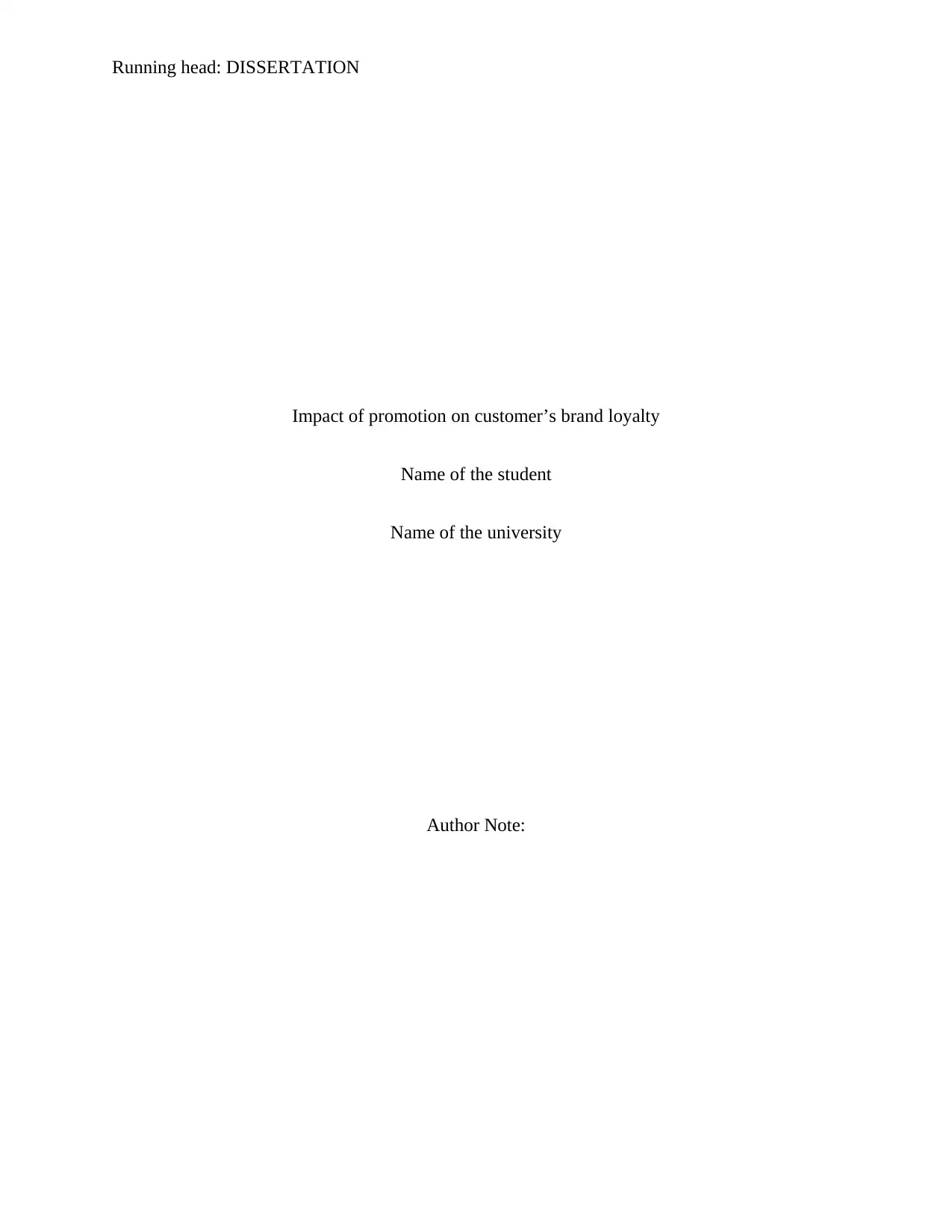
Running head: DISSERTATION
Impact of promotion on customer’s brand loyalty
Name of the student
Name of the university
Author Note:
Impact of promotion on customer’s brand loyalty
Name of the student
Name of the university
Author Note:
Paraphrase This Document
Need a fresh take? Get an instant paraphrase of this document with our AI Paraphraser
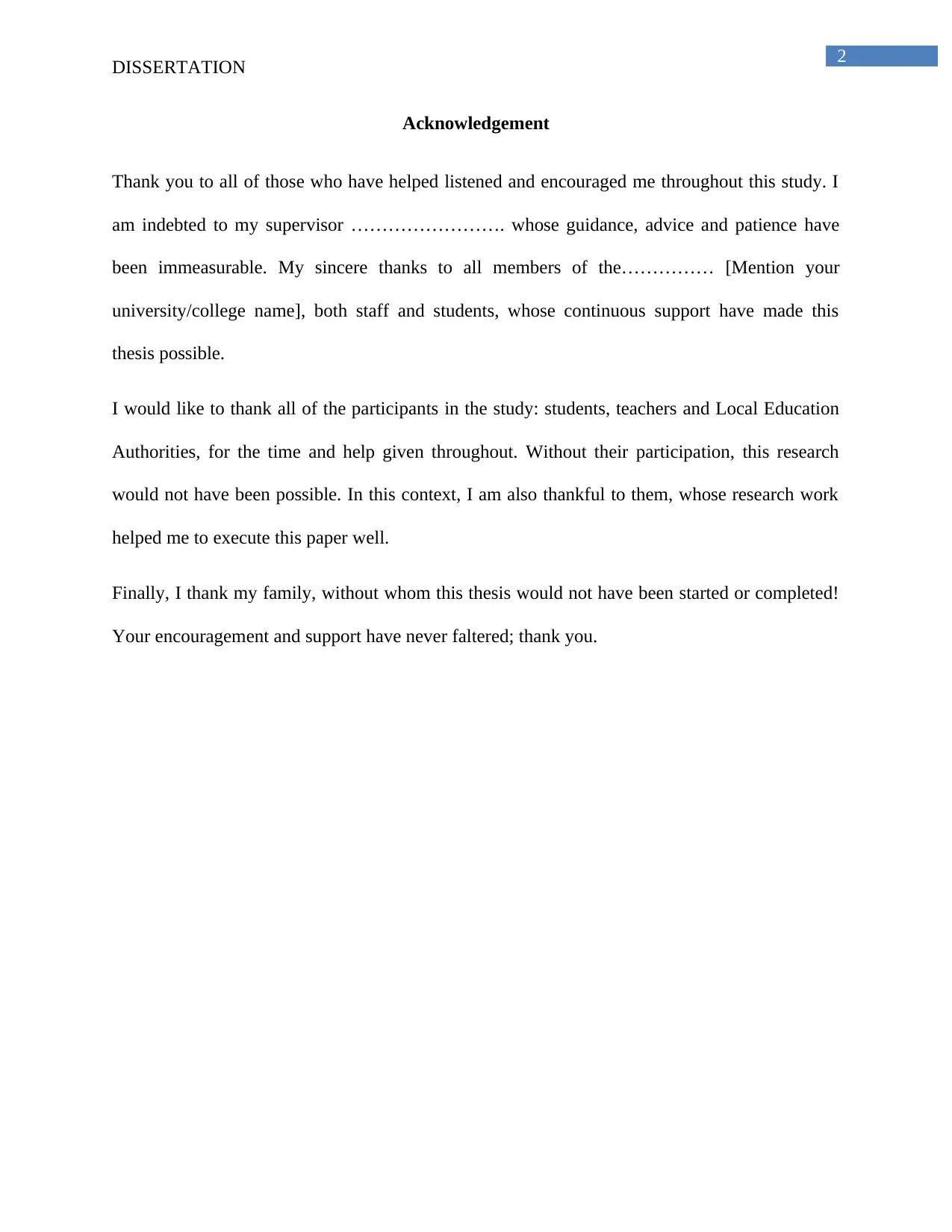
2
DISSERTATION
Acknowledgement
Thank you to all of those who have helped listened and encouraged me throughout this study. I
am indebted to my supervisor ……………………. whose guidance, advice and patience have
been immeasurable. My sincere thanks to all members of the…………… [Mention your
university/college name], both staff and students, whose continuous support have made this
thesis possible.
I would like to thank all of the participants in the study: students, teachers and Local Education
Authorities, for the time and help given throughout. Without their participation, this research
would not have been possible. In this context, I am also thankful to them, whose research work
helped me to execute this paper well.
Finally, I thank my family, without whom this thesis would not have been started or completed!
Your encouragement and support have never faltered; thank you.
DISSERTATION
Acknowledgement
Thank you to all of those who have helped listened and encouraged me throughout this study. I
am indebted to my supervisor ……………………. whose guidance, advice and patience have
been immeasurable. My sincere thanks to all members of the…………… [Mention your
university/college name], both staff and students, whose continuous support have made this
thesis possible.
I would like to thank all of the participants in the study: students, teachers and Local Education
Authorities, for the time and help given throughout. Without their participation, this research
would not have been possible. In this context, I am also thankful to them, whose research work
helped me to execute this paper well.
Finally, I thank my family, without whom this thesis would not have been started or completed!
Your encouragement and support have never faltered; thank you.
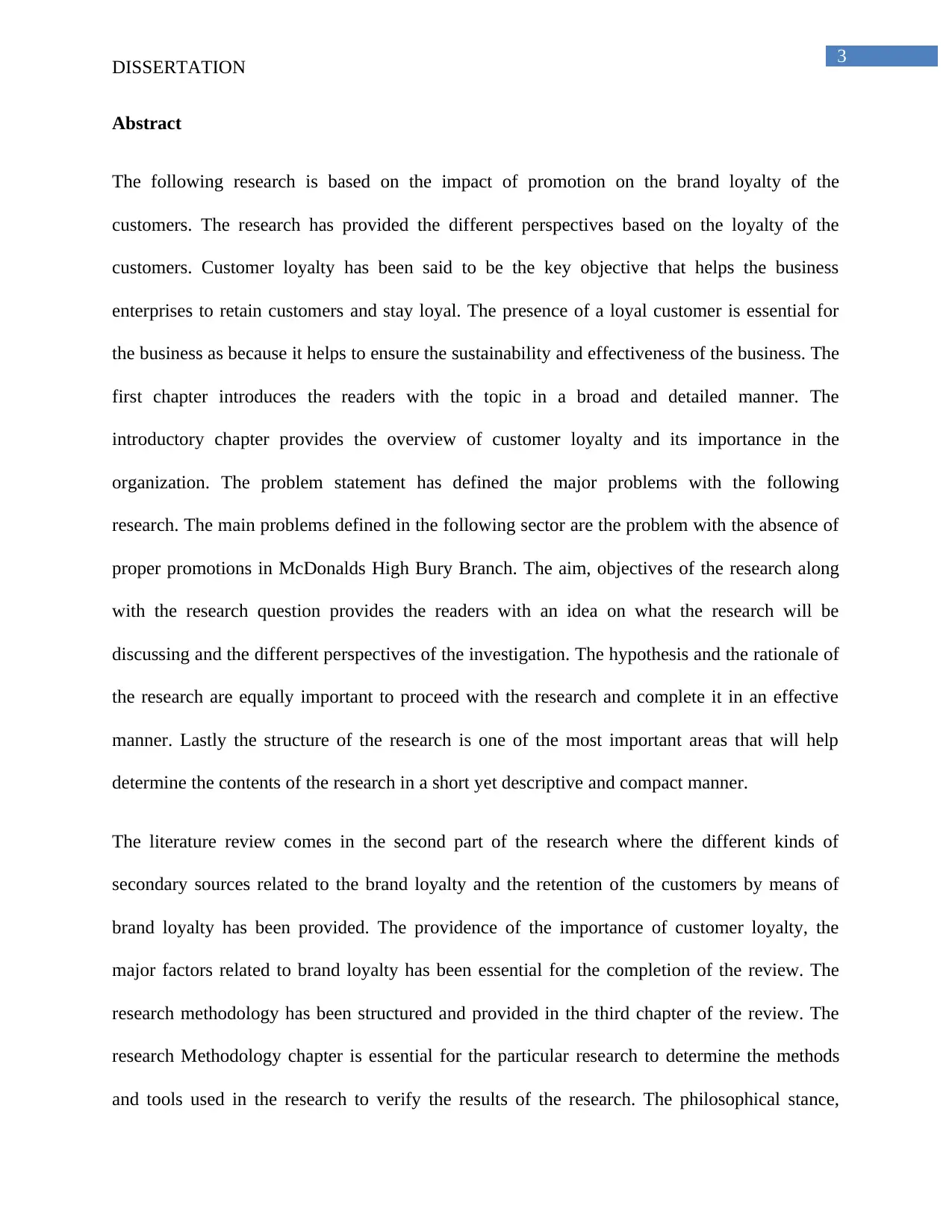
3
DISSERTATION
Abstract
The following research is based on the impact of promotion on the brand loyalty of the
customers. The research has provided the different perspectives based on the loyalty of the
customers. Customer loyalty has been said to be the key objective that helps the business
enterprises to retain customers and stay loyal. The presence of a loyal customer is essential for
the business as because it helps to ensure the sustainability and effectiveness of the business. The
first chapter introduces the readers with the topic in a broad and detailed manner. The
introductory chapter provides the overview of customer loyalty and its importance in the
organization. The problem statement has defined the major problems with the following
research. The main problems defined in the following sector are the problem with the absence of
proper promotions in McDonalds High Bury Branch. The aim, objectives of the research along
with the research question provides the readers with an idea on what the research will be
discussing and the different perspectives of the investigation. The hypothesis and the rationale of
the research are equally important to proceed with the research and complete it in an effective
manner. Lastly the structure of the research is one of the most important areas that will help
determine the contents of the research in a short yet descriptive and compact manner.
The literature review comes in the second part of the research where the different kinds of
secondary sources related to the brand loyalty and the retention of the customers by means of
brand loyalty has been provided. The providence of the importance of customer loyalty, the
major factors related to brand loyalty has been essential for the completion of the review. The
research methodology has been structured and provided in the third chapter of the review. The
research Methodology chapter is essential for the particular research to determine the methods
and tools used in the research to verify the results of the research. The philosophical stance,
DISSERTATION
Abstract
The following research is based on the impact of promotion on the brand loyalty of the
customers. The research has provided the different perspectives based on the loyalty of the
customers. Customer loyalty has been said to be the key objective that helps the business
enterprises to retain customers and stay loyal. The presence of a loyal customer is essential for
the business as because it helps to ensure the sustainability and effectiveness of the business. The
first chapter introduces the readers with the topic in a broad and detailed manner. The
introductory chapter provides the overview of customer loyalty and its importance in the
organization. The problem statement has defined the major problems with the following
research. The main problems defined in the following sector are the problem with the absence of
proper promotions in McDonalds High Bury Branch. The aim, objectives of the research along
with the research question provides the readers with an idea on what the research will be
discussing and the different perspectives of the investigation. The hypothesis and the rationale of
the research are equally important to proceed with the research and complete it in an effective
manner. Lastly the structure of the research is one of the most important areas that will help
determine the contents of the research in a short yet descriptive and compact manner.
The literature review comes in the second part of the research where the different kinds of
secondary sources related to the brand loyalty and the retention of the customers by means of
brand loyalty has been provided. The providence of the importance of customer loyalty, the
major factors related to brand loyalty has been essential for the completion of the review. The
research methodology has been structured and provided in the third chapter of the review. The
research Methodology chapter is essential for the particular research to determine the methods
and tools used in the research to verify the results of the research. The philosophical stance,
⊘ This is a preview!⊘
Do you want full access?
Subscribe today to unlock all pages.

Trusted by 1+ million students worldwide
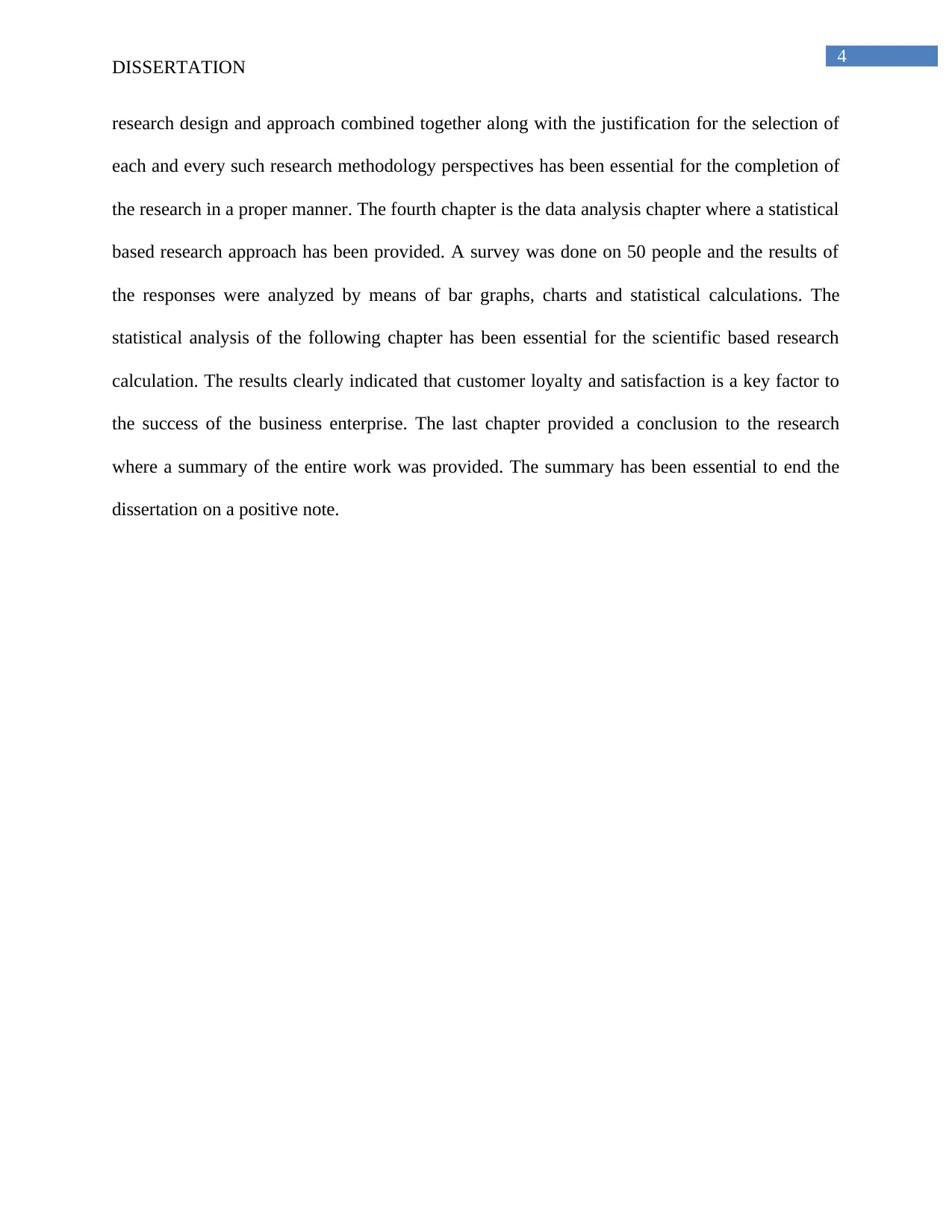
4
DISSERTATION
research design and approach combined together along with the justification for the selection of
each and every such research methodology perspectives has been essential for the completion of
the research in a proper manner. The fourth chapter is the data analysis chapter where a statistical
based research approach has been provided. A survey was done on 50 people and the results of
the responses were analyzed by means of bar graphs, charts and statistical calculations. The
statistical analysis of the following chapter has been essential for the scientific based research
calculation. The results clearly indicated that customer loyalty and satisfaction is a key factor to
the success of the business enterprise. The last chapter provided a conclusion to the research
where a summary of the entire work was provided. The summary has been essential to end the
dissertation on a positive note.
DISSERTATION
research design and approach combined together along with the justification for the selection of
each and every such research methodology perspectives has been essential for the completion of
the research in a proper manner. The fourth chapter is the data analysis chapter where a statistical
based research approach has been provided. A survey was done on 50 people and the results of
the responses were analyzed by means of bar graphs, charts and statistical calculations. The
statistical analysis of the following chapter has been essential for the scientific based research
calculation. The results clearly indicated that customer loyalty and satisfaction is a key factor to
the success of the business enterprise. The last chapter provided a conclusion to the research
where a summary of the entire work was provided. The summary has been essential to end the
dissertation on a positive note.
Paraphrase This Document
Need a fresh take? Get an instant paraphrase of this document with our AI Paraphraser
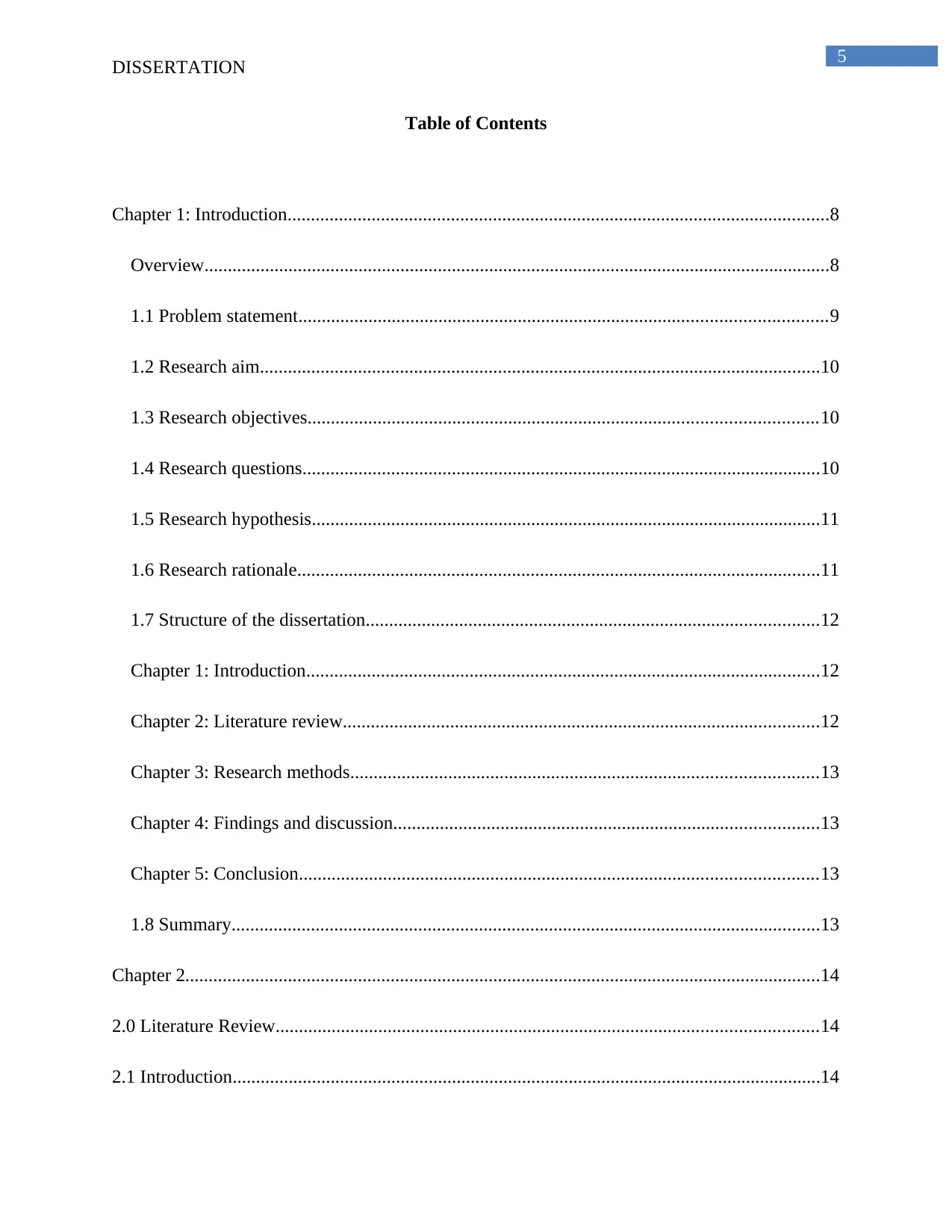
5
DISSERTATION
Table of Contents
Chapter 1: Introduction....................................................................................................................8
Overview......................................................................................................................................8
1.1 Problem statement.................................................................................................................9
1.2 Research aim........................................................................................................................10
1.3 Research objectives.............................................................................................................10
1.4 Research questions...............................................................................................................10
1.5 Research hypothesis.............................................................................................................11
1.6 Research rationale................................................................................................................11
1.7 Structure of the dissertation.................................................................................................12
Chapter 1: Introduction..............................................................................................................12
Chapter 2: Literature review......................................................................................................12
Chapter 3: Research methods....................................................................................................13
Chapter 4: Findings and discussion...........................................................................................13
Chapter 5: Conclusion...............................................................................................................13
1.8 Summary..............................................................................................................................13
Chapter 2........................................................................................................................................14
2.0 Literature Review....................................................................................................................14
2.1 Introduction..............................................................................................................................14
DISSERTATION
Table of Contents
Chapter 1: Introduction....................................................................................................................8
Overview......................................................................................................................................8
1.1 Problem statement.................................................................................................................9
1.2 Research aim........................................................................................................................10
1.3 Research objectives.............................................................................................................10
1.4 Research questions...............................................................................................................10
1.5 Research hypothesis.............................................................................................................11
1.6 Research rationale................................................................................................................11
1.7 Structure of the dissertation.................................................................................................12
Chapter 1: Introduction..............................................................................................................12
Chapter 2: Literature review......................................................................................................12
Chapter 3: Research methods....................................................................................................13
Chapter 4: Findings and discussion...........................................................................................13
Chapter 5: Conclusion...............................................................................................................13
1.8 Summary..............................................................................................................................13
Chapter 2........................................................................................................................................14
2.0 Literature Review....................................................................................................................14
2.1 Introduction..............................................................................................................................14
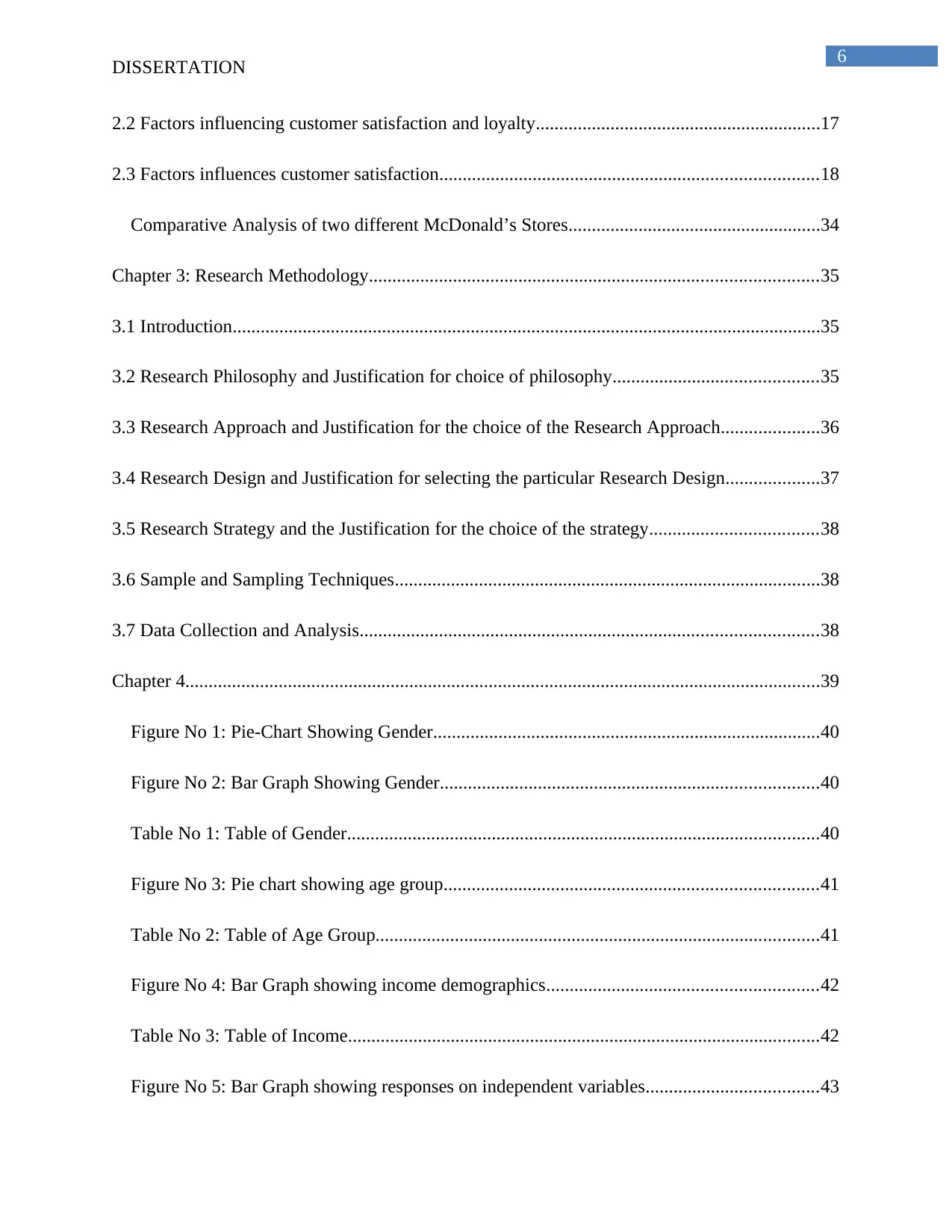
6
DISSERTATION
2.2 Factors influencing customer satisfaction and loyalty.............................................................17
2.3 Factors influences customer satisfaction.................................................................................18
Comparative Analysis of two different McDonald’s Stores......................................................34
Chapter 3: Research Methodology................................................................................................35
3.1 Introduction..............................................................................................................................35
3.2 Research Philosophy and Justification for choice of philosophy............................................35
3.3 Research Approach and Justification for the choice of the Research Approach.....................36
3.4 Research Design and Justification for selecting the particular Research Design....................37
3.5 Research Strategy and the Justification for the choice of the strategy....................................38
3.6 Sample and Sampling Techniques...........................................................................................38
3.7 Data Collection and Analysis..................................................................................................38
Chapter 4........................................................................................................................................39
Figure No 1: Pie-Chart Showing Gender...................................................................................40
Figure No 2: Bar Graph Showing Gender.................................................................................40
Table No 1: Table of Gender.....................................................................................................40
Figure No 3: Pie chart showing age group................................................................................41
Table No 2: Table of Age Group...............................................................................................41
Figure No 4: Bar Graph showing income demographics..........................................................42
Table No 3: Table of Income.....................................................................................................42
Figure No 5: Bar Graph showing responses on independent variables.....................................43
DISSERTATION
2.2 Factors influencing customer satisfaction and loyalty.............................................................17
2.3 Factors influences customer satisfaction.................................................................................18
Comparative Analysis of two different McDonald’s Stores......................................................34
Chapter 3: Research Methodology................................................................................................35
3.1 Introduction..............................................................................................................................35
3.2 Research Philosophy and Justification for choice of philosophy............................................35
3.3 Research Approach and Justification for the choice of the Research Approach.....................36
3.4 Research Design and Justification for selecting the particular Research Design....................37
3.5 Research Strategy and the Justification for the choice of the strategy....................................38
3.6 Sample and Sampling Techniques...........................................................................................38
3.7 Data Collection and Analysis..................................................................................................38
Chapter 4........................................................................................................................................39
Figure No 1: Pie-Chart Showing Gender...................................................................................40
Figure No 2: Bar Graph Showing Gender.................................................................................40
Table No 1: Table of Gender.....................................................................................................40
Figure No 3: Pie chart showing age group................................................................................41
Table No 2: Table of Age Group...............................................................................................41
Figure No 4: Bar Graph showing income demographics..........................................................42
Table No 3: Table of Income.....................................................................................................42
Figure No 5: Bar Graph showing responses on independent variables.....................................43
⊘ This is a preview!⊘
Do you want full access?
Subscribe today to unlock all pages.

Trusted by 1+ million students worldwide
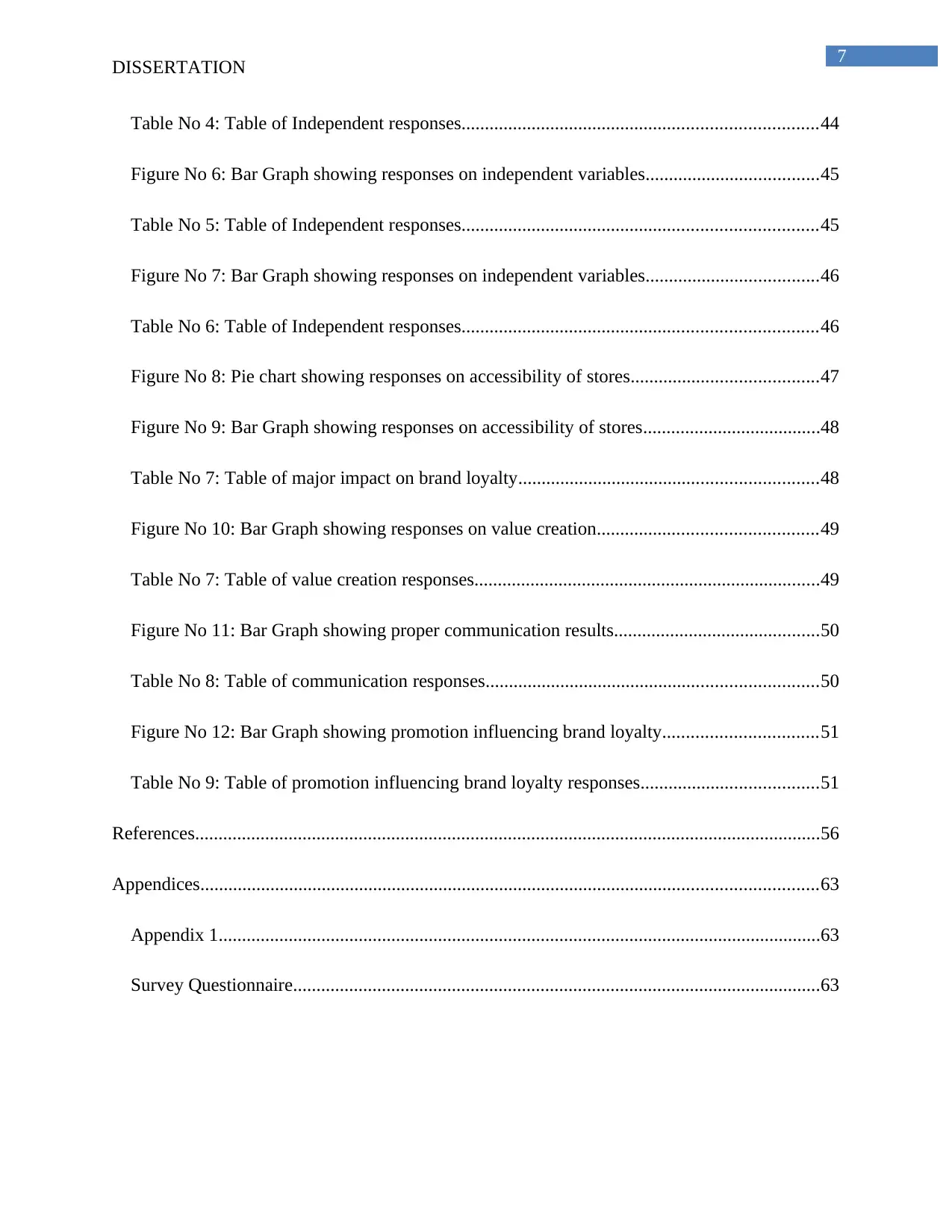
7
DISSERTATION
Table No 4: Table of Independent responses............................................................................44
Figure No 6: Bar Graph showing responses on independent variables.....................................45
Table No 5: Table of Independent responses............................................................................45
Figure No 7: Bar Graph showing responses on independent variables.....................................46
Table No 6: Table of Independent responses............................................................................46
Figure No 8: Pie chart showing responses on accessibility of stores........................................47
Figure No 9: Bar Graph showing responses on accessibility of stores......................................48
Table No 7: Table of major impact on brand loyalty................................................................48
Figure No 10: Bar Graph showing responses on value creation...............................................49
Table No 7: Table of value creation responses..........................................................................49
Figure No 11: Bar Graph showing proper communication results............................................50
Table No 8: Table of communication responses.......................................................................50
Figure No 12: Bar Graph showing promotion influencing brand loyalty.................................51
Table No 9: Table of promotion influencing brand loyalty responses......................................51
References......................................................................................................................................56
Appendices....................................................................................................................................63
Appendix 1.................................................................................................................................63
Survey Questionnaire.................................................................................................................63
DISSERTATION
Table No 4: Table of Independent responses............................................................................44
Figure No 6: Bar Graph showing responses on independent variables.....................................45
Table No 5: Table of Independent responses............................................................................45
Figure No 7: Bar Graph showing responses on independent variables.....................................46
Table No 6: Table of Independent responses............................................................................46
Figure No 8: Pie chart showing responses on accessibility of stores........................................47
Figure No 9: Bar Graph showing responses on accessibility of stores......................................48
Table No 7: Table of major impact on brand loyalty................................................................48
Figure No 10: Bar Graph showing responses on value creation...............................................49
Table No 7: Table of value creation responses..........................................................................49
Figure No 11: Bar Graph showing proper communication results............................................50
Table No 8: Table of communication responses.......................................................................50
Figure No 12: Bar Graph showing promotion influencing brand loyalty.................................51
Table No 9: Table of promotion influencing brand loyalty responses......................................51
References......................................................................................................................................56
Appendices....................................................................................................................................63
Appendix 1.................................................................................................................................63
Survey Questionnaire.................................................................................................................63
Paraphrase This Document
Need a fresh take? Get an instant paraphrase of this document with our AI Paraphraser
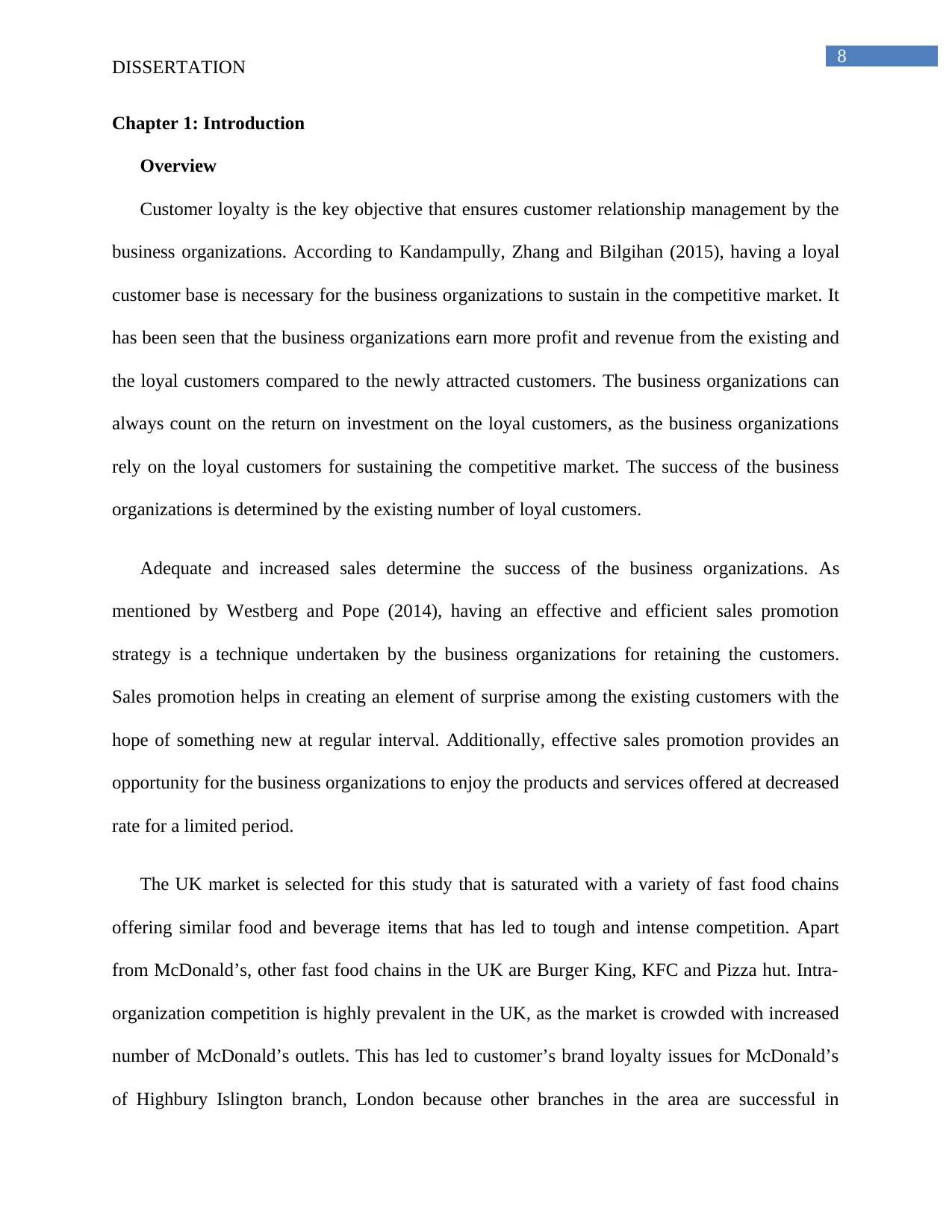
8
DISSERTATION
Chapter 1: Introduction
Overview
Customer loyalty is the key objective that ensures customer relationship management by the
business organizations. According to Kandampully, Zhang and Bilgihan (2015), having a loyal
customer base is necessary for the business organizations to sustain in the competitive market. It
has been seen that the business organizations earn more profit and revenue from the existing and
the loyal customers compared to the newly attracted customers. The business organizations can
always count on the return on investment on the loyal customers, as the business organizations
rely on the loyal customers for sustaining the competitive market. The success of the business
organizations is determined by the existing number of loyal customers.
Adequate and increased sales determine the success of the business organizations. As
mentioned by Westberg and Pope (2014), having an effective and efficient sales promotion
strategy is a technique undertaken by the business organizations for retaining the customers.
Sales promotion helps in creating an element of surprise among the existing customers with the
hope of something new at regular interval. Additionally, effective sales promotion provides an
opportunity for the business organizations to enjoy the products and services offered at decreased
rate for a limited period.
The UK market is selected for this study that is saturated with a variety of fast food chains
offering similar food and beverage items that has led to tough and intense competition. Apart
from McDonald’s, other fast food chains in the UK are Burger King, KFC and Pizza hut. Intra-
organization competition is highly prevalent in the UK, as the market is crowded with increased
number of McDonald’s outlets. This has led to customer’s brand loyalty issues for McDonald’s
of Highbury Islington branch, London because other branches in the area are successful in
DISSERTATION
Chapter 1: Introduction
Overview
Customer loyalty is the key objective that ensures customer relationship management by the
business organizations. According to Kandampully, Zhang and Bilgihan (2015), having a loyal
customer base is necessary for the business organizations to sustain in the competitive market. It
has been seen that the business organizations earn more profit and revenue from the existing and
the loyal customers compared to the newly attracted customers. The business organizations can
always count on the return on investment on the loyal customers, as the business organizations
rely on the loyal customers for sustaining the competitive market. The success of the business
organizations is determined by the existing number of loyal customers.
Adequate and increased sales determine the success of the business organizations. As
mentioned by Westberg and Pope (2014), having an effective and efficient sales promotion
strategy is a technique undertaken by the business organizations for retaining the customers.
Sales promotion helps in creating an element of surprise among the existing customers with the
hope of something new at regular interval. Additionally, effective sales promotion provides an
opportunity for the business organizations to enjoy the products and services offered at decreased
rate for a limited period.
The UK market is selected for this study that is saturated with a variety of fast food chains
offering similar food and beverage items that has led to tough and intense competition. Apart
from McDonald’s, other fast food chains in the UK are Burger King, KFC and Pizza hut. Intra-
organization competition is highly prevalent in the UK, as the market is crowded with increased
number of McDonald’s outlets. This has led to customer’s brand loyalty issues for McDonald’s
of Highbury Islington branch, London because other branches in the area are successful in
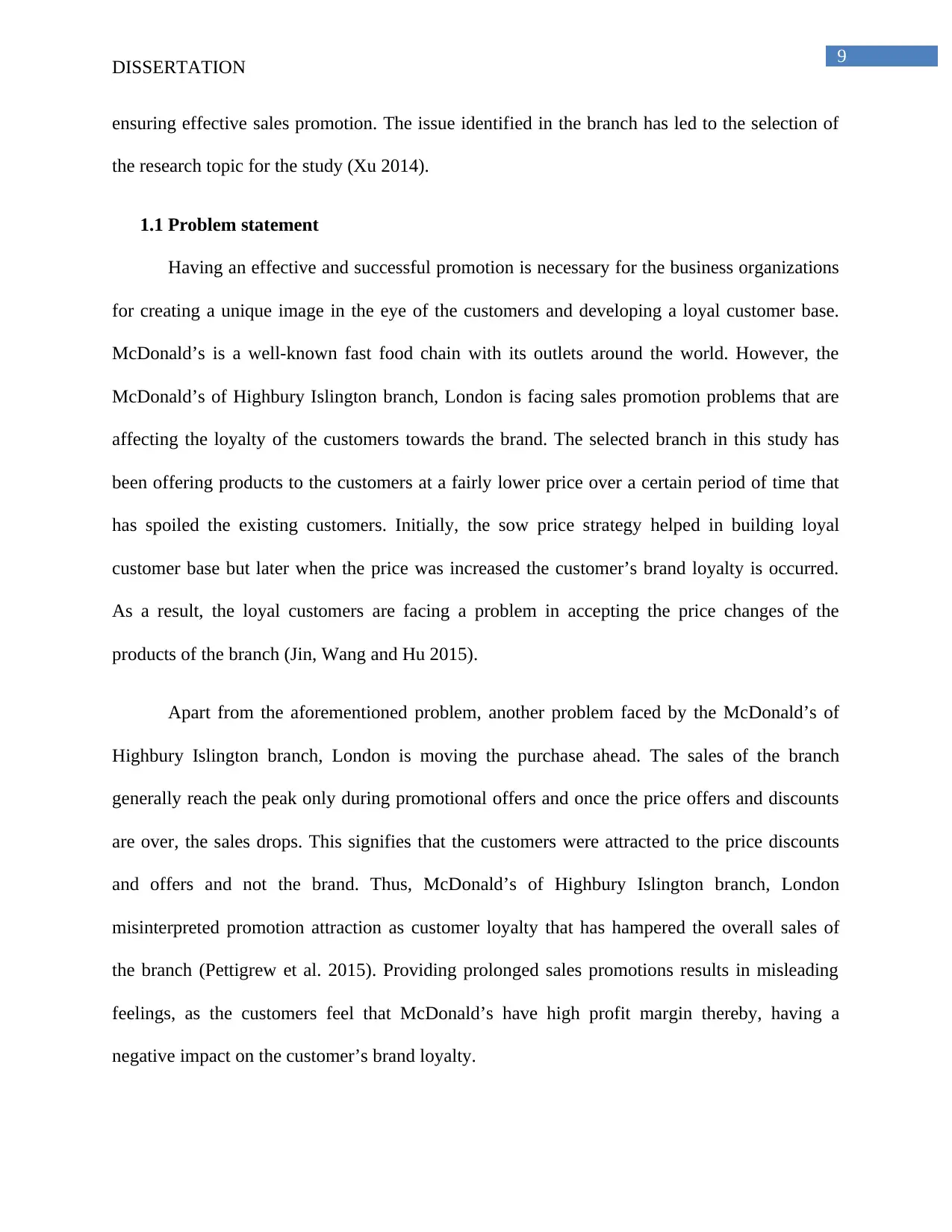
9
DISSERTATION
ensuring effective sales promotion. The issue identified in the branch has led to the selection of
the research topic for the study (Xu 2014).
1.1 Problem statement
Having an effective and successful promotion is necessary for the business organizations
for creating a unique image in the eye of the customers and developing a loyal customer base.
McDonald’s is a well-known fast food chain with its outlets around the world. However, the
McDonald’s of Highbury Islington branch, London is facing sales promotion problems that are
affecting the loyalty of the customers towards the brand. The selected branch in this study has
been offering products to the customers at a fairly lower price over a certain period of time that
has spoiled the existing customers. Initially, the sow price strategy helped in building loyal
customer base but later when the price was increased the customer’s brand loyalty is occurred.
As a result, the loyal customers are facing a problem in accepting the price changes of the
products of the branch (Jin, Wang and Hu 2015).
Apart from the aforementioned problem, another problem faced by the McDonald’s of
Highbury Islington branch, London is moving the purchase ahead. The sales of the branch
generally reach the peak only during promotional offers and once the price offers and discounts
are over, the sales drops. This signifies that the customers were attracted to the price discounts
and offers and not the brand. Thus, McDonald’s of Highbury Islington branch, London
misinterpreted promotion attraction as customer loyalty that has hampered the overall sales of
the branch (Pettigrew et al. 2015). Providing prolonged sales promotions results in misleading
feelings, as the customers feel that McDonald’s have high profit margin thereby, having a
negative impact on the customer’s brand loyalty.
DISSERTATION
ensuring effective sales promotion. The issue identified in the branch has led to the selection of
the research topic for the study (Xu 2014).
1.1 Problem statement
Having an effective and successful promotion is necessary for the business organizations
for creating a unique image in the eye of the customers and developing a loyal customer base.
McDonald’s is a well-known fast food chain with its outlets around the world. However, the
McDonald’s of Highbury Islington branch, London is facing sales promotion problems that are
affecting the loyalty of the customers towards the brand. The selected branch in this study has
been offering products to the customers at a fairly lower price over a certain period of time that
has spoiled the existing customers. Initially, the sow price strategy helped in building loyal
customer base but later when the price was increased the customer’s brand loyalty is occurred.
As a result, the loyal customers are facing a problem in accepting the price changes of the
products of the branch (Jin, Wang and Hu 2015).
Apart from the aforementioned problem, another problem faced by the McDonald’s of
Highbury Islington branch, London is moving the purchase ahead. The sales of the branch
generally reach the peak only during promotional offers and once the price offers and discounts
are over, the sales drops. This signifies that the customers were attracted to the price discounts
and offers and not the brand. Thus, McDonald’s of Highbury Islington branch, London
misinterpreted promotion attraction as customer loyalty that has hampered the overall sales of
the branch (Pettigrew et al. 2015). Providing prolonged sales promotions results in misleading
feelings, as the customers feel that McDonald’s have high profit margin thereby, having a
negative impact on the customer’s brand loyalty.
⊘ This is a preview!⊘
Do you want full access?
Subscribe today to unlock all pages.

Trusted by 1+ million students worldwide
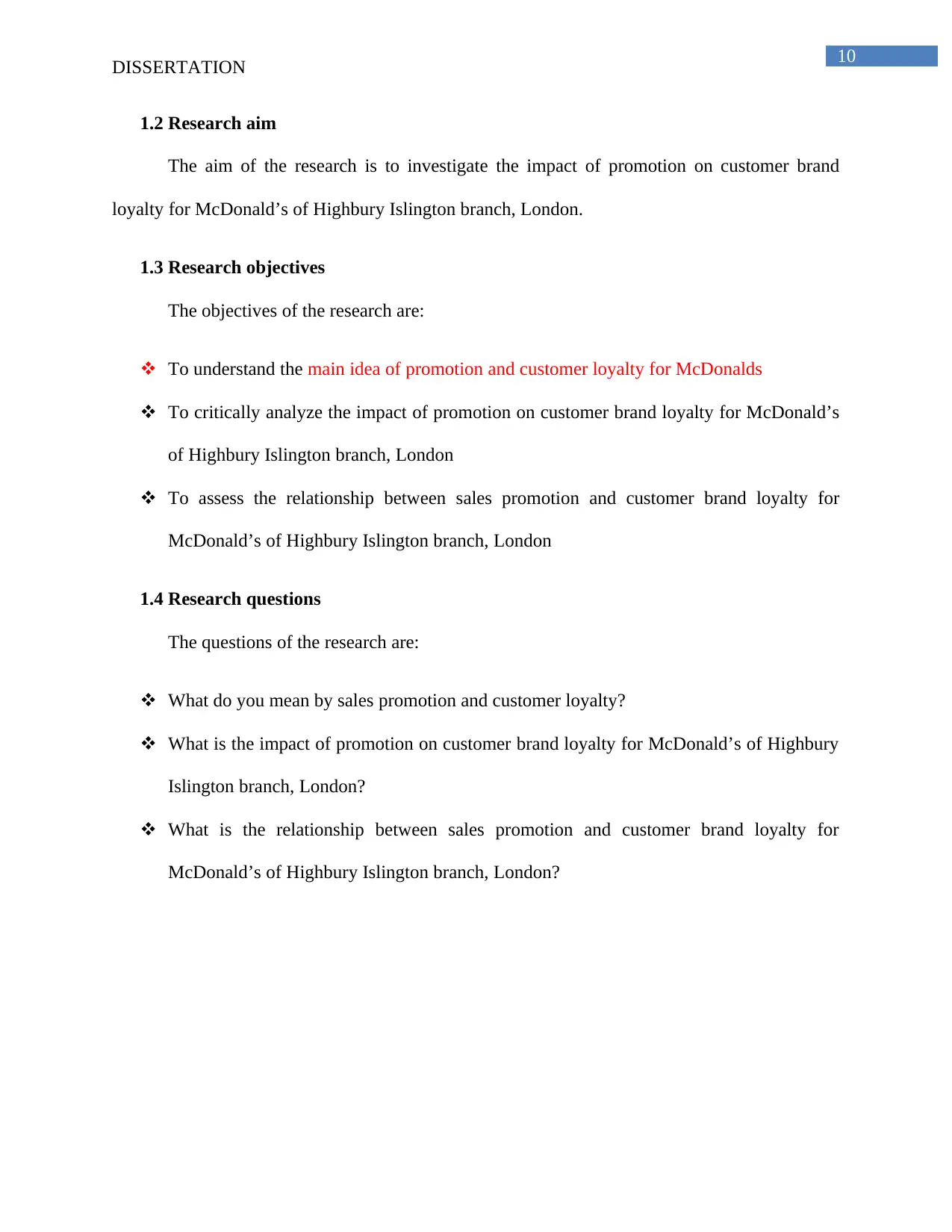
10
DISSERTATION
1.2 Research aim
The aim of the research is to investigate the impact of promotion on customer brand
loyalty for McDonald’s of Highbury Islington branch, London.
1.3 Research objectives
The objectives of the research are:
To understand the main idea of promotion and customer loyalty for McDonalds
To critically analyze the impact of promotion on customer brand loyalty for McDonald’s
of Highbury Islington branch, London
To assess the relationship between sales promotion and customer brand loyalty for
McDonald’s of Highbury Islington branch, London
1.4 Research questions
The questions of the research are:
What do you mean by sales promotion and customer loyalty?
What is the impact of promotion on customer brand loyalty for McDonald’s of Highbury
Islington branch, London?
What is the relationship between sales promotion and customer brand loyalty for
McDonald’s of Highbury Islington branch, London?
DISSERTATION
1.2 Research aim
The aim of the research is to investigate the impact of promotion on customer brand
loyalty for McDonald’s of Highbury Islington branch, London.
1.3 Research objectives
The objectives of the research are:
To understand the main idea of promotion and customer loyalty for McDonalds
To critically analyze the impact of promotion on customer brand loyalty for McDonald’s
of Highbury Islington branch, London
To assess the relationship between sales promotion and customer brand loyalty for
McDonald’s of Highbury Islington branch, London
1.4 Research questions
The questions of the research are:
What do you mean by sales promotion and customer loyalty?
What is the impact of promotion on customer brand loyalty for McDonald’s of Highbury
Islington branch, London?
What is the relationship between sales promotion and customer brand loyalty for
McDonald’s of Highbury Islington branch, London?
Paraphrase This Document
Need a fresh take? Get an instant paraphrase of this document with our AI Paraphraser
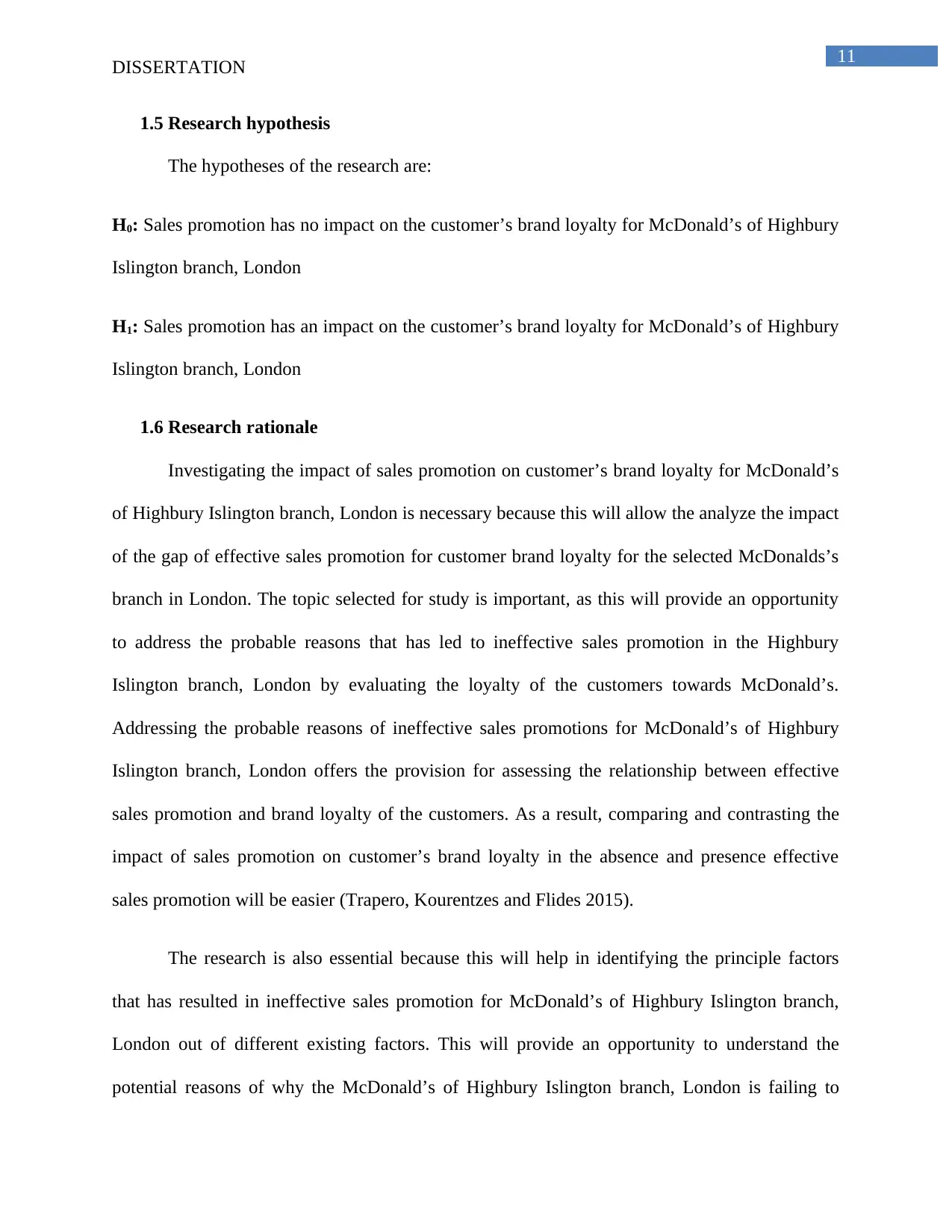
11
DISSERTATION
1.5 Research hypothesis
The hypotheses of the research are:
H0: Sales promotion has no impact on the customer’s brand loyalty for McDonald’s of Highbury
Islington branch, London
H1: Sales promotion has an impact on the customer’s brand loyalty for McDonald’s of Highbury
Islington branch, London
1.6 Research rationale
Investigating the impact of sales promotion on customer’s brand loyalty for McDonald’s
of Highbury Islington branch, London is necessary because this will allow the analyze the impact
of the gap of effective sales promotion for customer brand loyalty for the selected McDonalds’s
branch in London. The topic selected for study is important, as this will provide an opportunity
to address the probable reasons that has led to ineffective sales promotion in the Highbury
Islington branch, London by evaluating the loyalty of the customers towards McDonald’s.
Addressing the probable reasons of ineffective sales promotions for McDonald’s of Highbury
Islington branch, London offers the provision for assessing the relationship between effective
sales promotion and brand loyalty of the customers. As a result, comparing and contrasting the
impact of sales promotion on customer’s brand loyalty in the absence and presence effective
sales promotion will be easier (Trapero, Kourentzes and Flides 2015).
The research is also essential because this will help in identifying the principle factors
that has resulted in ineffective sales promotion for McDonald’s of Highbury Islington branch,
London out of different existing factors. This will provide an opportunity to understand the
potential reasons of why the McDonald’s of Highbury Islington branch, London is failing to
DISSERTATION
1.5 Research hypothesis
The hypotheses of the research are:
H0: Sales promotion has no impact on the customer’s brand loyalty for McDonald’s of Highbury
Islington branch, London
H1: Sales promotion has an impact on the customer’s brand loyalty for McDonald’s of Highbury
Islington branch, London
1.6 Research rationale
Investigating the impact of sales promotion on customer’s brand loyalty for McDonald’s
of Highbury Islington branch, London is necessary because this will allow the analyze the impact
of the gap of effective sales promotion for customer brand loyalty for the selected McDonalds’s
branch in London. The topic selected for study is important, as this will provide an opportunity
to address the probable reasons that has led to ineffective sales promotion in the Highbury
Islington branch, London by evaluating the loyalty of the customers towards McDonald’s.
Addressing the probable reasons of ineffective sales promotions for McDonald’s of Highbury
Islington branch, London offers the provision for assessing the relationship between effective
sales promotion and brand loyalty of the customers. As a result, comparing and contrasting the
impact of sales promotion on customer’s brand loyalty in the absence and presence effective
sales promotion will be easier (Trapero, Kourentzes and Flides 2015).
The research is also essential because this will help in identifying the principle factors
that has resulted in ineffective sales promotion for McDonald’s of Highbury Islington branch,
London out of different existing factors. This will provide an opportunity to understand the
potential reasons of why the McDonald’s of Highbury Islington branch, London is failing to
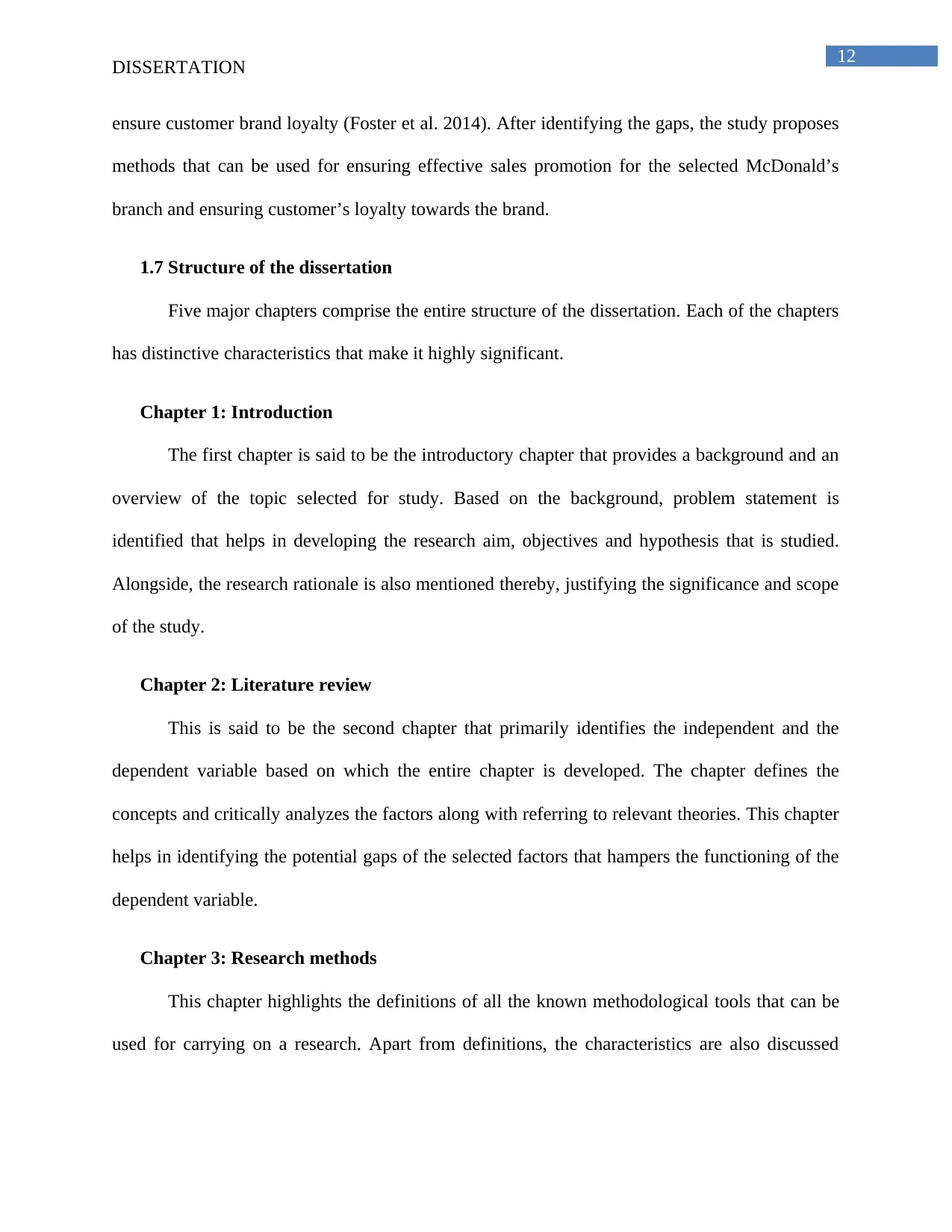
12
DISSERTATION
ensure customer brand loyalty (Foster et al. 2014). After identifying the gaps, the study proposes
methods that can be used for ensuring effective sales promotion for the selected McDonald’s
branch and ensuring customer’s loyalty towards the brand.
1.7 Structure of the dissertation
Five major chapters comprise the entire structure of the dissertation. Each of the chapters
has distinctive characteristics that make it highly significant.
Chapter 1: Introduction
The first chapter is said to be the introductory chapter that provides a background and an
overview of the topic selected for study. Based on the background, problem statement is
identified that helps in developing the research aim, objectives and hypothesis that is studied.
Alongside, the research rationale is also mentioned thereby, justifying the significance and scope
of the study.
Chapter 2: Literature review
This is said to be the second chapter that primarily identifies the independent and the
dependent variable based on which the entire chapter is developed. The chapter defines the
concepts and critically analyzes the factors along with referring to relevant theories. This chapter
helps in identifying the potential gaps of the selected factors that hampers the functioning of the
dependent variable.
Chapter 3: Research methods
This chapter highlights the definitions of all the known methodological tools that can be
used for carrying on a research. Apart from definitions, the characteristics are also discussed
DISSERTATION
ensure customer brand loyalty (Foster et al. 2014). After identifying the gaps, the study proposes
methods that can be used for ensuring effective sales promotion for the selected McDonald’s
branch and ensuring customer’s loyalty towards the brand.
1.7 Structure of the dissertation
Five major chapters comprise the entire structure of the dissertation. Each of the chapters
has distinctive characteristics that make it highly significant.
Chapter 1: Introduction
The first chapter is said to be the introductory chapter that provides a background and an
overview of the topic selected for study. Based on the background, problem statement is
identified that helps in developing the research aim, objectives and hypothesis that is studied.
Alongside, the research rationale is also mentioned thereby, justifying the significance and scope
of the study.
Chapter 2: Literature review
This is said to be the second chapter that primarily identifies the independent and the
dependent variable based on which the entire chapter is developed. The chapter defines the
concepts and critically analyzes the factors along with referring to relevant theories. This chapter
helps in identifying the potential gaps of the selected factors that hampers the functioning of the
dependent variable.
Chapter 3: Research methods
This chapter highlights the definitions of all the known methodological tools that can be
used for carrying on a research. Apart from definitions, the characteristics are also discussed
⊘ This is a preview!⊘
Do you want full access?
Subscribe today to unlock all pages.

Trusted by 1+ million students worldwide
1 out of 59
Related Documents
Your All-in-One AI-Powered Toolkit for Academic Success.
+13062052269
info@desklib.com
Available 24*7 on WhatsApp / Email
![[object Object]](/_next/static/media/star-bottom.7253800d.svg)
Unlock your academic potential
Copyright © 2020–2025 A2Z Services. All Rights Reserved. Developed and managed by ZUCOL.





